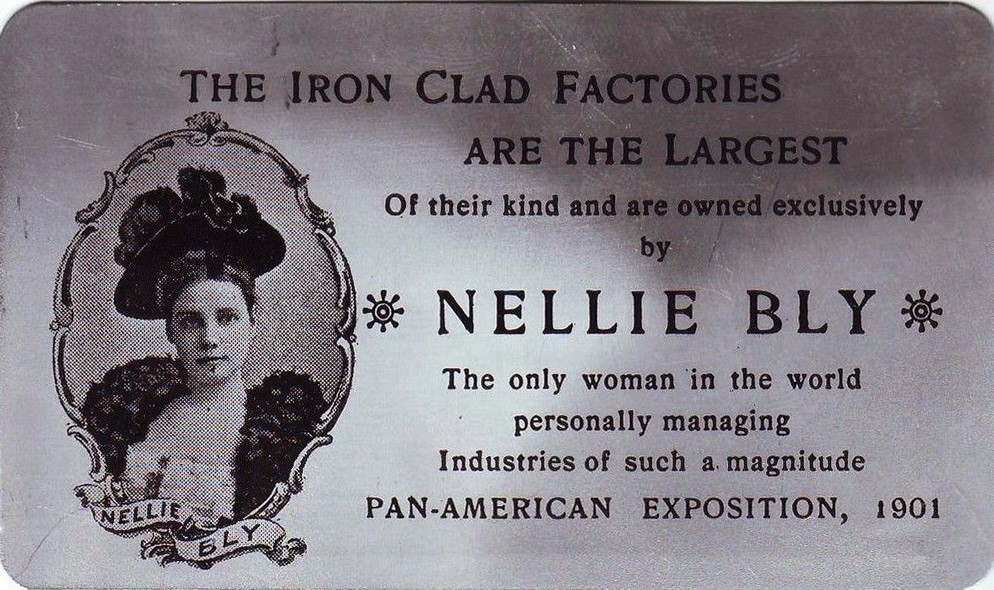The indefatigable Nellie Bly
Evan Zabawski | TLT From the Editor May 2018
An industrialist and inventor better known as a pioneering journalist.

She patented both a milk can and stacking garbage can under her married name, Elizabeth Seaman Cochrane, but capitalized on her pen name on her metal calling cards.
Photo courtesy of http://antoniosalasjournalist.blogspot.ca/2015/02/.
Though people may not recognize the name Elizabeth Jane Cochran, they may know the pen name Nellie Bly. However, her real name is closely attached to an everyday item primarily used in the lubricants industry. Since she was born on May 5, 1864, this month seems like a fitting time to recount her story.
Elizabeth’s father, Michael Cochran, was a mill worker who worked hard and eventually purchased the local mills (a gristmill, sawmill and fulling mill) in 1858. The settlement, part of Armstrong County in Pennsylvania, became known as Cochran Mills. Despite becoming the county judge, when Michael died in 1870 he left his wife, Mary Jane, without a will and, therefore, no legal claim to his estate.
Three years later Mary Jane remarried, but the man was so abusive that she sought divorce, which further weakened her financial position. In an effort to support her mother, Elizabeth enrolled at Indiana State Normal School in September 1879, under the name Cochrane, to study to become a teacher. Unable to afford tuition for a second semester, her family moved to Pittsburgh and ran a boarding house.
In 1885 Elizabeth wrote a reply to a letter published in the Pittsburg Dispatch titled What Girls Are Good For. She wrote her open letter using the pseudonym Lonely Orphan Girl, which the editor of the paper, George Madden, printed as a rebuttal and also asked that the writer identify herself. When she did, Madden asked her to write another piece under the same pseudonym. Titled The Girl Puzzle, a piece on how divorce affected women, which also suggested reforms to divorce law and a radical concept now known as pay equality, it impressed Madden enough to offer her a full-time job as a columnist.
Being customary for female writers at the time to use pen names, Madden selected Nelly Bly from the then-popular eponymous song by Stephen Foster, a songwriter known for Oh! Susanna, Camptown Races, Swanee River and Jeanie with the Light Brown Hair, among others, but mistakenly wrote it out as Nellie Bly, and the error stuck.
After tiring of reporting on the theater and arts, Nellie left the paper in 1887 and headed to New York City where she eventually talked her way into the managing editor’s office at The New York World. Here she gained notoriety by going undercover as a patient of an insane asylum and reporting on its appalling conditions and treatment of patients. In 1889 she embarked on her most famous assignment by travelling around the world faster than Jules Verne’s character Phileas Fogg, completing the trip in just over 72 days.
Though the newspaper’s circulation increased dramatically by promoting a contest to guess her estimated arrival time, Nellie received no bonus and subsequently resigned from the paper. In 1893 a new editor convinced her to come back, and she continued to write for The World for three more years. In 1895 Nellie married industrialist Robert Seaman (aged 73), owner of the Iron Clad Manufacturing Co.—makers of milk cans and other steel products.
Due to Seaman’s failing health, she became more involved with the company, and in 1901 she patented both a milk can and a stacking garbage can under her married name, Elizabeth Seaman Cochrane, but capitalized on her pen name on her metal calling cards. After Seaman died on March 11, 1904, Elizabeth became president of Iron Clad and, as such, assignee to any future patents by its employees.
One employee, superintendent Henry Wehrhahn, filed two such patents exactly eight months later, which were granted on Dec. 26, 1905. His first patent reads, “My invention has for its object to provide a metal barrel which shall be simple and strong in construction and effective and durable in operation,” and the second, “for readily detaching and securing the head of a metal barrel.”
This was the first practical 55-gallon steel drum, which evolved into the standard oil drum design still used today.
Evan Zabawski, CLS, is the senior technical advisor for TestOil in Calgary, Alberta, Canada. You can reach him at ezabawski@testoil.com.